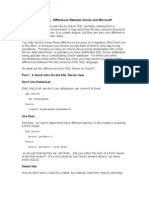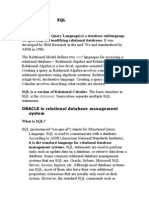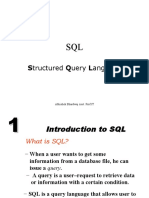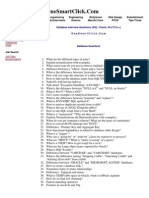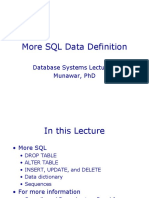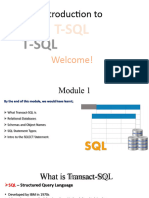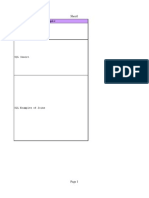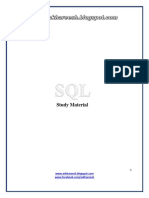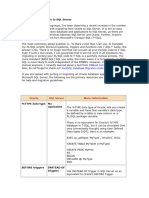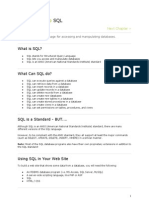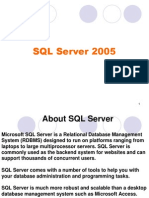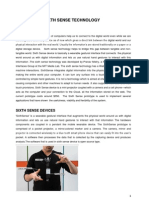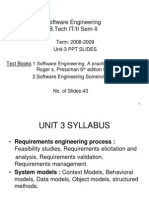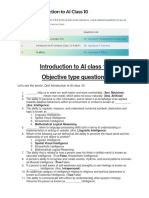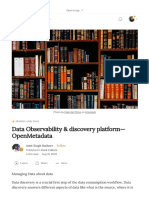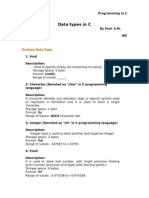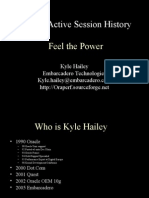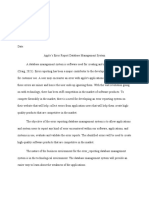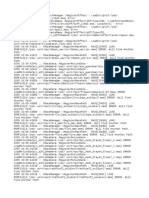BEGINNING SQL: DIFFERENCES BETWEEN SQL SERVER AND ORACLE
A Quick Intro for SQL Server Users
�Introduction
If you're new to SQL or just new to Oracle SQL, perhaps coming from a Microsoft SQL Server environment, it may seem like the two versions should be very similar, and they are, to a certain degree, but they are also very different in some important and basic ways.
�Agenda
I. Quick Intro for SQL Server Users II. Some Detail: Joins, Subqueries, Deletes III. Certain Conceptual Differences IV. Powerful New Features V. Summary & References
�Dont Use Databases
SQL Server
use mydatabase
Oracle
connect mydatabase/mypassword
�Use Dual
SQL Server
select getdate();
Oracle
select sysdate from dual;
�Select Into
SQL Server
select getdate() mycolumn into mytable;
Oracle
insert into mytable (mycolumn) values(sysdate);
�Inserts
SQL Server
Insert mytable values(more text);
Oracle
Insert into mytable values(more text);
�Updates
SQL Server
update mytable set mycolumn=myothertable.mycolumn from mytable,myothertable where mytable.mycolumn like 'MY%' and myothertable.myothercolumn='some text';
�Updates
Oracle
update mytable set mycolumn= (select a.mycolumn from myothertable a where myothertable.myothercolumn='some text ) where mytable.mycolumn like 'MY%';
�Deletes
SQL Server
delete mytable where mycolumn like 'some%';
Oracle
delete from mytable where mycolumn like 'some%';
�Software
SQL Server isql osql: for queries developed in SQL Analyzer
Oracle
sqlplus
�II. A Little More Detail
Outer Join
Sub-Queries in Place of Columns Deletes With a Second From Clause
�Outer Join
SQL Server select d.deptname, e.ename from dept d, emp e where d.empno *= e.enum; Oracle select d.deptname,e.ename from dept d, emp e where d.empno = e.enum (+);
�SubQueries in Place of Columns SQL Server
select distinct year, q1 = (select Amount amt FROM sales where Quarter=1 AND year = s.year), q2 = (SELECT Amount amt FROM sales where Quarter=2 AND year = s.year), q3 = (SELECT Amount amt FROM sales where Quarter=3 AND year = s.year), q4 = (SELECT Amount amt FROM sales where Quarter=4 AND year = s.year)
from sales s;
�SubQueries in Place of Columns
Oracle
SELECT year, DECODE( quarter, DECODE( quarter, DECODE( quarter, DECODE( quarter, FROM sales s; 1, 2, 3, 4, amount, amount, amount, amount, 0 0 0 0 ) ) ) ) q1, q2, q3, q4
�Delete with Second From Clause
SQL Server
delete from products from products, product_deletes where products.a = product_deletes.a and products.b = product_deletes.b and product_deletes.c = 'd';
�Delete with Second From Clause
Oracle
delete from products where ( a, b ) in ( select a, b from product_deletes where c = 'd' );
�III. More Depth
The Connect Concept
Other Conceptual Differences Data Type Differences Column Aliases Sub-Queries
�The Connect Concept
SQL Server Multiple databases Oracle Single Database Multiple tablespaces, schemas, users
�Other Conceptual Differences
SQL Server
Database owner, DBO Group/Role Non-unique index T-SQL stored procedure { Trigger Compex rule Column identity property
Oracle
Schema Role Index PL/SQL procedure PL/SQL function BEFORE trigger After trigger Sequence
�Only in Oracle
Clusters
Packages Triggers for each row Synonyms Snapshots
�Data Type Differences
SQL Server
INTEGER
Oracle
NUMBER(10)
SMALLINT
TINYINT REAL FLOAT BIT VARCHAR(n) TEXT IMAGE BINARY(n)
NUMBER(6)
NUMBER(3) FLOAT FLOAT NUMBER(1) VARCHAR2(n) CLOB BLOB RAW(n) or BLOB
�Data Type Differences
SQL Server
VARBINARY
Oracle
RAW(n) or BLOB
DATETIME
SMALL-DATETIME MONEY NCHAR(n) NVARCHAR(n) SMALLMONEY TIMESTAMP SYSNAME
DATE
DATE NUMBER(19,4) CHAR(n*2) VARCHAR(n*2) NUMBER(10,4) NUMBER VARCHAR2(30), VARCHAR2(128)
�Time
SQL Server Datetime: 1/300th second Oracle Date: 1 second Timestamp: 1/100 millionth second
�Column Aliases
SQL Server select a=deptid, b=deptname,c=empno from dept; Oracle select deptid a, deptname b, empno c from dept;
�Sub-queries, again
SQL Server
SELECT ename, deptname FROM emp, dept WHERE emp.enum = 10 AND(SELECT security_code FROM employee_security WHERE empno = emp.enum) =
(SELECT security_code FROM security_master
WHERE sec_level = dept.sec_level);
�Sub-queries, again
Oracle
SELECT empname, deptname FROM emp, dept WHERE emp.empno = 10 AND EXISTS (SELECT security_code FROM employee_security es WHERE es.empno = emp.empno AND es.security_code =
(SELECT security_code FROM security_master WHERE sec_level = dept.sec_level));
�Powerful New Features
Regular Expressions: Operators & Functions
Operator: REGEXP_LIKE Functions: REGEXP_INSTR
REGEXP_SUBSTR REGEXP_REPLACE
�Regular Expressions
Select zip from zipcode where regexp_like (zip, [^[:digit:]]);
�Regular Expressions
SELECT REGEXP_INSTR('Joe Smith, 10045 Berry Lane, San Joseph, CA 912341234', ' [[:digit:]]{5}(-[[:digit:]]{4})?$') AS starts_at FROM dual
�Summary
This discussion has been an attempt at a light and lively introduction to the Oracle database world for those familiar with the Microsoft SQL Server database products. Much more in-depth examples are available in the references shown that follow, from which many of the examples were drawn and for which we can thank the authors involved. Welcome Aboard!
�References
Oracle Migration Workbench Reference Guide for
SQL Server and Sybase Adaptive Server Migrations, Release 9.2.0 for Microsoft Windows 98/2000/NT and Microsoft Windows XP, Part Number B10254-01 Oracle Technology Network, OTN:
http://otn.oracle.com/software/index.html
Writing Better SQL Using Regular Expressions, By
Alice Rischert
http://otn.oracle.com/oramag/webcolumns/2003/te charticles/rischert_regexp_pt1.html
